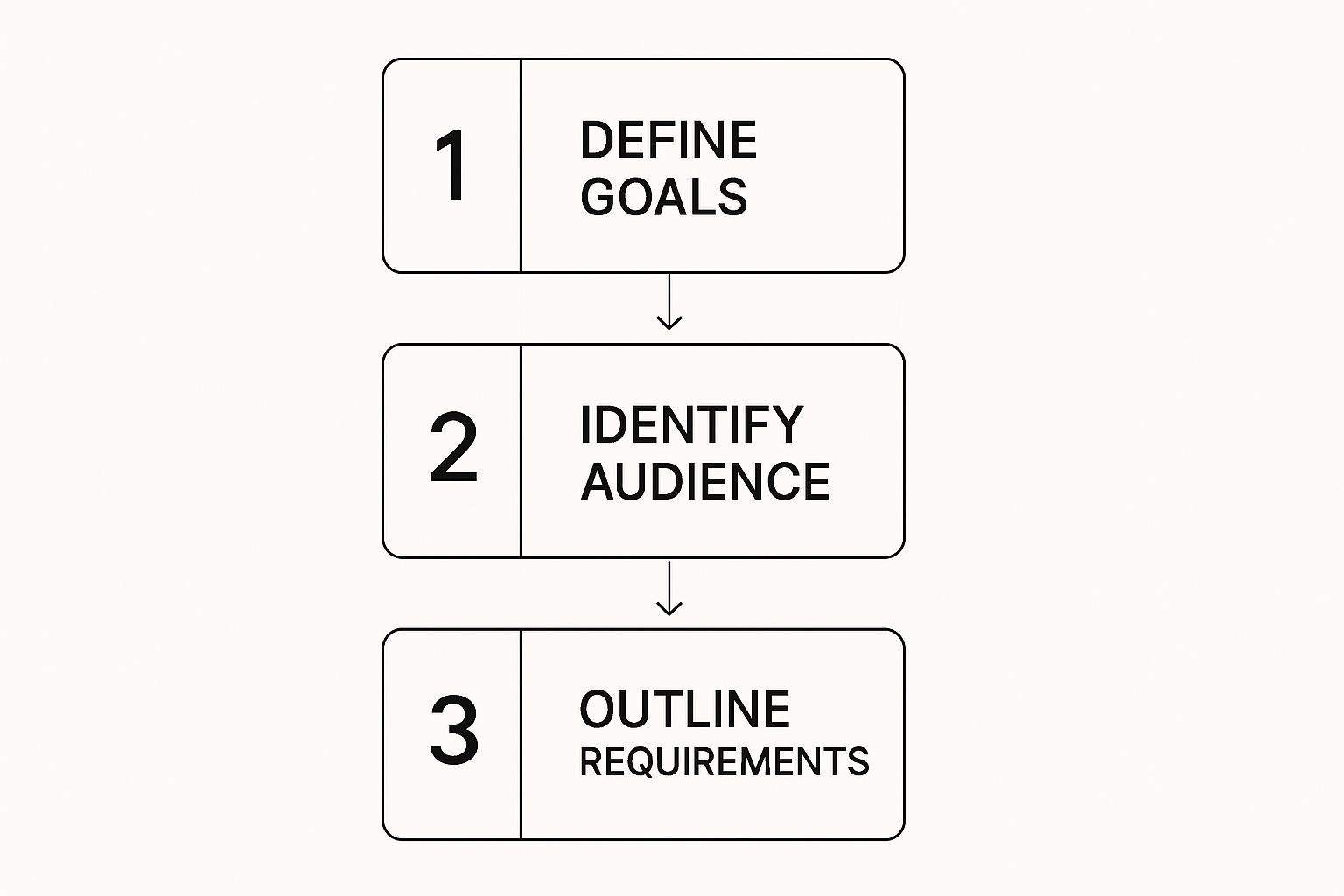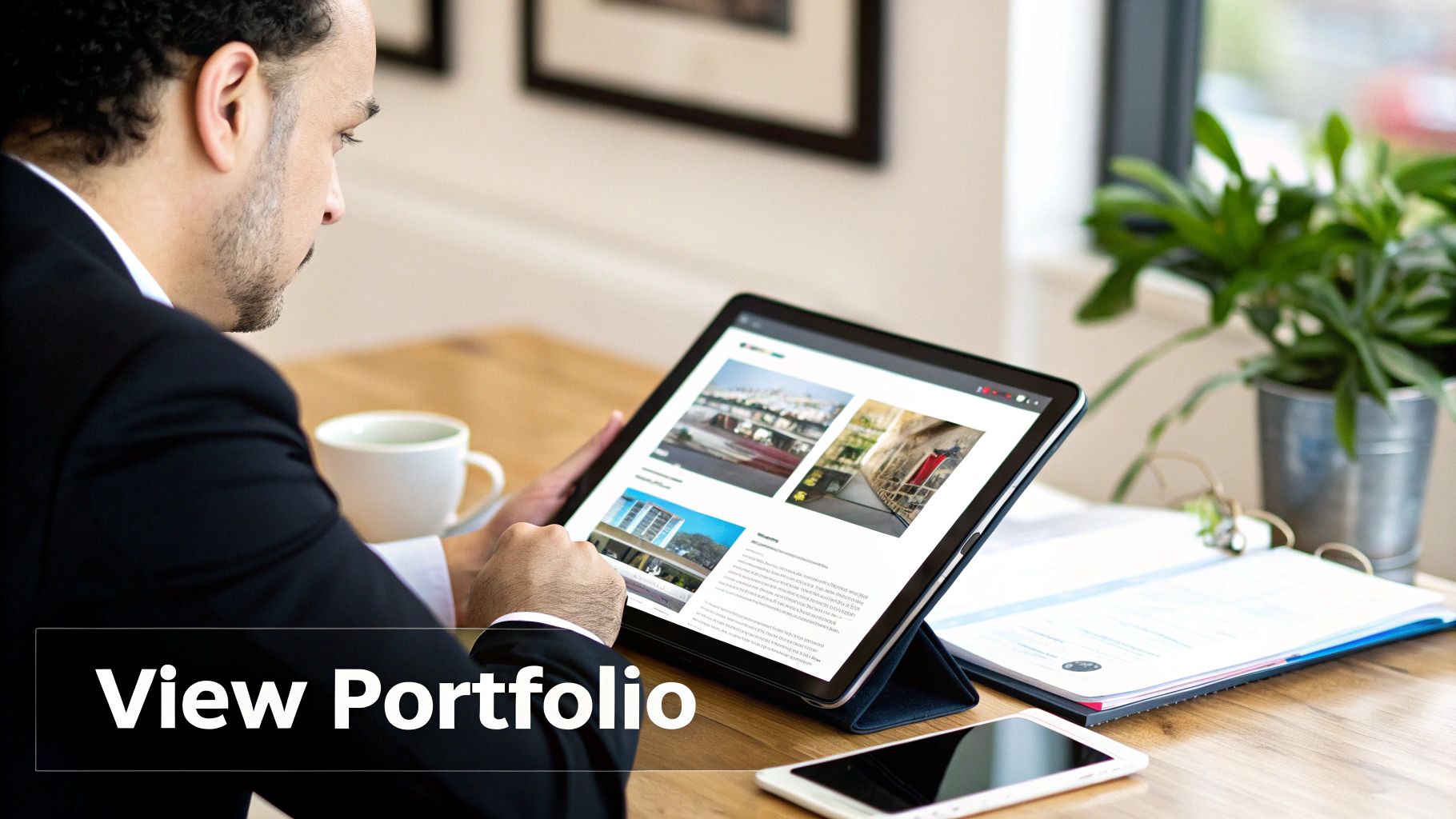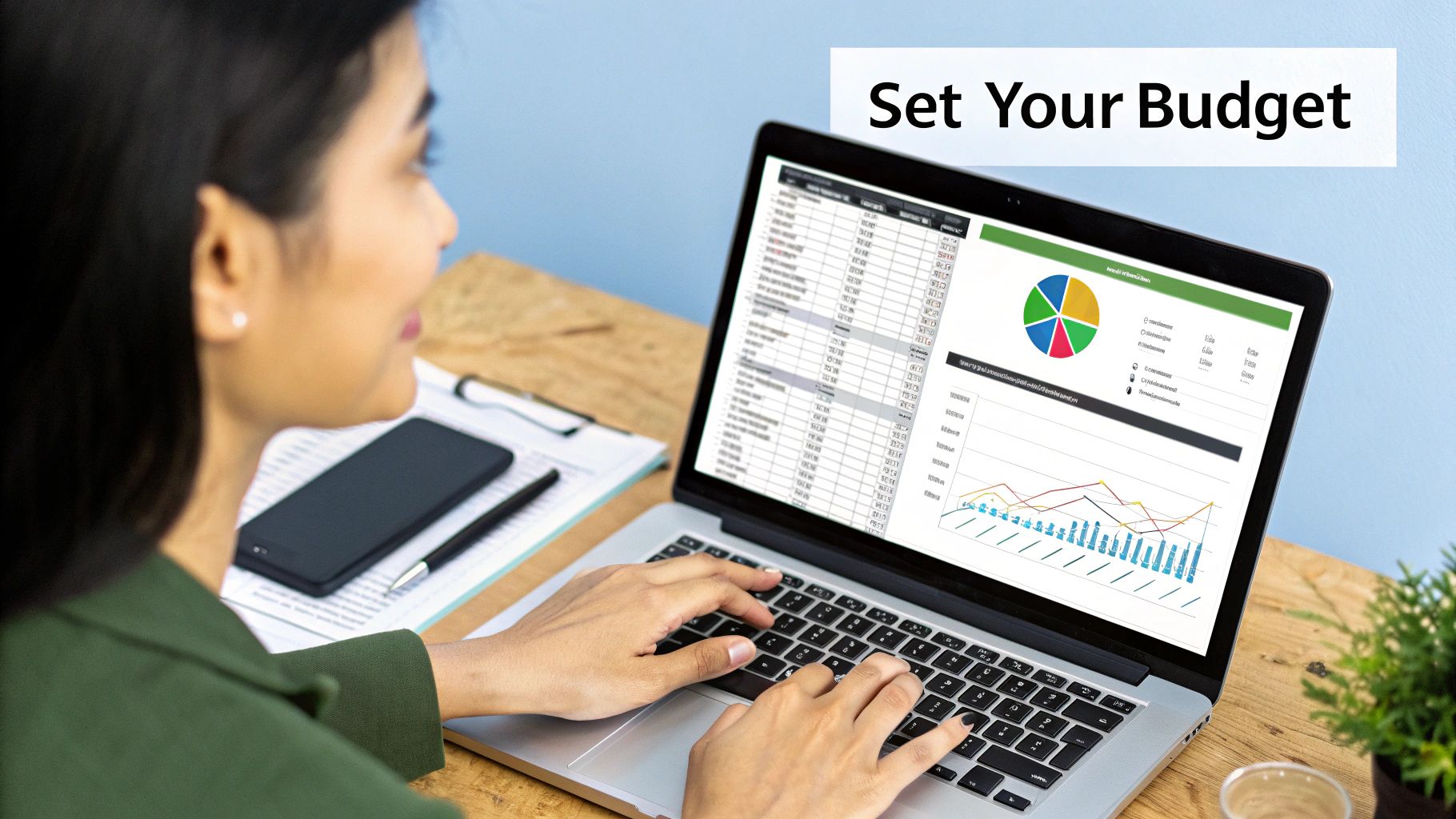Before you even think about searching for a web design agency, the most important work happens internally. It all starts with getting crystal clear on what you actually need. Without this initial groundwork, you’re just window shopping. Taking the time to define your goals, audience, and must-have features is what separates a successful website project from a frustrating and expensive one.
This clarity ensures you find a partner who gets your vision and can build a site that genuinely moves your business forward.
First Things First: Define Your Project
Jumping into agency portfolios without a clear plan is a recipe for disaster. It’s like setting off on a road trip with no map and no destination—you’ll burn through time and money, and you probably won’t like where you end up. The single most critical step in this entire process is creating a detailed project brief before you speak to a single agency.
A good brief is more than just saying, “I need a new website.” It forces you to get to the heart of why you’re doing this. Are you trying to boost online sales? Generate more qualified leads? Or is this about establishing your brand as a thought leader? Each of these goals demands a completely different strategy and design approach. A lead generation site, for instance, will be all about prominent calls-to-action and simple contact forms, while an e-commerce site lives or dies by its seamless checkout experience.
Get Specific About Your Business Goals
Let’s start by defining what success actually looks like for this new website. Vague goals like “get more traffic” are useless because they’re impossible to measure. Instead, get specific. Aim for something like, “increase organic search traffic by 20% within six months of launch.” This kind of precision tells an agency exactly what you’re trying to achieve and allows them to propose a strategy that delivers real, measurable ROI.
It’s also crucial to grasp the market context. Consider this: the global e-commerce market is projected to swell from $3.3 trillion to a staggering $5.4 trillion by 2026. That’s a massive opportunity, but it also means the competition is fierce. You need an agency that understands how to build a high-performing site capable of carving out a piece of that pie.
Key Takeaway: Your website isn’t a digital pamphlet; it’s a powerful business tool. The whole point of a project brief is to define exactly what you expect that tool to do for you.
Pinpoint Your Audience and List Your Must-Haves
Okay, you know what you want to achieve. Now, who are you trying to reach? You need to get inside the head of your ideal customer.
- What problems are they trying to solve?
- What information are they desperately searching for?
- What will make their lives easier?
Every single design choice—from the site navigation to the tone of the copy—should be made with this person in mind.
This simple flow chart shows how these foundational steps connect and build on one another.
As you can see, your goals inform who your audience is, and both of those elements determine what features your site needs to have.
Finally, make a practical checklist of every function your website absolutely must include. Do you need e-commerce capabilities? A secure client login area? A blog? Integration with your CRM or email marketing software like Mailchimp?
To get a better sense of how these requirements translate into a final product, it can be helpful to look at real-world examples. You can browse through a variety of completed projects in our portfolio to see how different functionalities come to life.
Having this list ready makes it incredibly easy to filter through agency proposals and immediately see who has truly listened and who is just sending a generic template. This upfront clarity helps agencies give you a far more accurate quote and, most importantly, ensures the website they build for you is perfectly aligned with your business objectives from day one.
Project Needs Self-Assessment Checklist
To help you get started, I’ve put together a simple checklist. Use this table to organize your thoughts and build the foundation of your project brief before you start your search for an agency.
| Area of Consideration | Key Questions to Answer | My Project Requirements |
|---|---|---|
| Primary Business Goals | What is the #1 objective of this website? (e.g., Lead Gen, Sales, Brand Awareness) What does success look like in 6-12 months? | |
| Target Audience | Who is your ideal customer? What are their main pain points or needs? | |
| Core Functionality | What must the site do? (e.g., Sell products, book appointments, showcase a portfolio) | |
| Content | Who will be creating the text, images, and videos? Do you need a blog? | |
| Technical Integrations | Does it need to connect with other software? (e.g., CRM, email platform, payment gateways) | |
| Budget & Timeline | What is your realistic budget range? What is your ideal launch date? |
Taking 30 minutes to fill this out will save you hours of confusion and put you in a position of power when you start talking to potential partners. You’ll be able to lead the conversation with confidence, knowing exactly what you need.
Look Beyond the Pretty Pictures
It’s easy to get wowed by a slick portfolio. But a great-looking website that doesn’t actually work is just a pretty (and expensive) digital billboard. You’re not just buying design; you’re investing in a business tool that needs to perform.
When you’re vetting an agency, you have to look for strategic thinking. Their past work is your main clue. Don’t just flip through screenshots—you need to dig in and find proof of real-world success.
Dig Into Case Studies for the Full Story
This is where case studies become your best friend. They’re much more revealing than a simple gallery of homepage designs because they should tell the full story: the why behind the project and the results that followed.
Look for hard numbers and specific outcomes. What measurable goal did they help a client hit?
- Better Conversion Rates: Did they boost the percentage of visitors who filled out a contact form or completed a purchase?
- Lower Bounce Rates: Does the data show they kept visitors from hitting the back button immediately?
- Higher User Engagement: Can they point to longer session times or more pages viewed per visit?
If an agency’s “case studies” are really just a collection of images without any context, that’s a warning sign. It often means they prioritize looks over performance.
A great website solves a business problem. When you’re looking at an agency’s past work, always ask: “What problem did this design solve, and where’s the proof?”
Test-Drive Their Work and Check Their Technical Chops
Beyond the reported results, you need to actually use the sites they’ve built. Go ahead, click around. Get a real feel for the user experience they deliver.
As you explore, pay attention to the basics. Is the navigation logical? Can you find what you’re looking for without thinking too hard? And how fast does it load? A slow website is a deal-breaker. Studies have shown that even a 1-second delay can tank conversions by 7%.
Pull up their portfolio sites on your phone, too. With more than half of all web traffic coming from mobile, a seamless mobile experience isn’t a bonus feature; it’s a must-have.
Finally, look for range. Do all their websites follow the same cookie-cutter template, or can they adapt their style to different brands and industries? An agency that can nail the design for a funky B2C startup and a buttoned-up B2B consulting firm has the versatility to bring your unique vision to life.
For more on how different design choices impact business goals, our guide on strategic website design offers some deeper insights. This kind of critical evaluation helps you find a true partner who builds powerful business tools, not just digital art.
Evaluating an Agency’s Technical Chops and Future-Readiness
A gorgeous website is worthless if it’s built on a crumbling foundation. You need a digital asset that grows with your business, not a technical headache that becomes a security risk in six months. When you’re vetting an agency, you have to dig deep into their actual technical skills and whether they build for the future.
This means looking past the pretty pictures to see what’s really going on under the hood. You want a partner who understands the web of today but is already thinking about tomorrow. A future-ready site is secure, works for everyone, and is built to adapt without a complete teardown.
What’s Under the Hood Matters
The Content Management System (CMS) is the engine of your website. It’s the backend you’ll use to add blog posts, swap out images, and keep things fresh. The CMS an agency defaults to tells you a ton about their technical philosophy and who they serve best.
WordPress: The undisputed king of CMSs, powering a massive chunk of the internet. It’s incredibly flexible, but that flexibility can be a double-edged sword. A true WordPress pro will talk about custom development, site speed optimization, and locking things down—not just installing a pre-made theme.
Shopify: The dominant force in e-commerce for a reason. If you’re selling products online, your agency needs to live and breathe the Shopify ecosystem, from complex app integrations to navigating the quirks of different payment gateways.
Webflow: This is a hallmark of a modern, design-focused agency. Webflow offers incredible design freedom without the heavy maintenance of a traditional coded site, making it a fantastic choice for marketing and corporate sites that need to look sharp.
Don’t just accept their recommendation at face value. Ask them why they believe a specific platform is the right fit for your project. A great partner won’t just push their favorite tool; they’ll connect their recommendation directly to your business goals, your team’s technical comfort level, and your plans for growth.
Key Insight: The right CMS should empower you, not trap you. Make sure the agency’s choice aligns with your long-term vision and gives you the control you need to scale.
The Technical Essentials Beyond the Build
A well-built website goes way beyond just clean code. It needs to be built on a bedrock of standards that ensure it performs well and lasts. This is where you separate the pros from the amateurs.
Get specific and ask them directly about their process for these critical areas:
Search Engine Optimization (SEO): How is SEO baked in from the start? A good answer involves more than just keywords. They should talk about building for mobile-first indexing, creating logical heading structures (H1, H2, H3), and obsessing over fast page load times. These are foundational elements, not afterthoughts.
Accessibility (a11y): How do you ensure the website is usable by people with disabilities? Look for a firm commitment to the Web Content Accessibility Guidelines (WCAG). This isn’t just about being inclusive (which is reason enough); it’s a growing legal necessity and a sign of a truly professional-grade agency.
Security Protocols: What’s your plan to keep my site secure? Vague answers won’t cut it. They need to confidently explain their approach to SSL certificates, secure hosting environments, and, most importantly, a plan for regular software updates and maintenance.
Ultimately, you’re not just hiring a designer. You’re looking for a technical partner who can be a strategic guide for your digital presence. Their technical acumen and commitment to building for the future will determine your site’s success, security, and scalability for years to come.
Gauging an Agency’s Communication and Process
A flashy portfolio and impressive technical skills are great, but they don’t mean a thing if the agency is impossible to work with. The most brilliant design concepts can fall apart without clear communication and a solid, predictable process. This is where the human element comes in, and frankly, it’s just as critical as their design chops.
Think of it this way: you’re not just buying a website; you’re entering into a partnership. The quality of that relationship will directly shape the final product. A truly collaborative and transparent partnership is what ensures the process runs smoothly and that the website you get is the one you actually envisioned.
Understanding Their Project Workflow
Every agency has its own rhythm for getting things done. Your job is to find one whose process clicks with your own team’s working style. Be wary of vague promises like “we’ll keep you updated.” That’s a red flag. You need to know exactly how they operate.
When you’re first talking to them, don’t be shy about getting into the nitty-gritty of their workflow. Ask them to walk you through a typical project, from the very first kickoff call to the final launch day and what happens after.
Here are a few specific questions you should absolutely ask:
- What project management tools do you live in? Knowing if they use platforms like Asana, Trello, or Basecamp shows they have a system to keep everything on track.
- What’s the cadence for progress updates? A professional agency will have scheduled check-ins, whether that’s a quick daily stand-up, a weekly review, or bi-weekly deep dives.
- Who is my go-to person? It’s crucial to know if you’ll have one dedicated project manager or if you’ll be talking to a different person every time you have a question.
A great agency relationship is built on transparent communication and a collaborative spirit. The process should feel like a partnership, not a transaction where you hand over money and hope for the best.
This level of detail is so important because a website’s look is only part of the equation. Good design guides user behavior, and the data backs this up. Research shows that 94% of first impressions are tied directly to design, and users form an opinion in a blistering 0.05 seconds. A collaborative process ensures the agency genuinely understands your business goals to make that split-second count. You can dig deeper into the impact of design on user perception here.
How They Handle Feedback and Changes
Let’s be real: no project goes exactly according to plan. New ideas will pop up, priorities might shift, and scope creep is always a possibility. The true mark of a professional agency is how they manage these inevitable bumps in the road.
Ask them point-blank about their process for handling client feedback and revisions. How many rounds of changes are baked into the initial proposal? What’s the protocol if you need to make a major pivot after the project has started?
An experienced team will have a clear, documented process for change orders. They should be able to explain exactly how they document, quote, and schedule new requests without throwing the entire project into chaos. This is a sign of maturity and experience.
By digging into these “how we work” questions, you get a much clearer picture of an agency’s professionalism and what it will actually be like to partner with them. A little due diligence here can save you a world of frustration and set your project up for success from day one.
Decoding Proposals and Pricing Structures
Once proposals start hitting your inbox, it’s time to shift gears. You’re no longer just window shopping for agencies; you’re dissecting what they’re actually offering. It’s so easy to just skip to the bottom line and compare the final numbers, but I can tell you from experience, the total cost is often the least important part of the story.
A great proposal is a roadmap, not just a price tag. It should give you a crystal-clear outline of the entire scope of work, a realistic timeline with specific milestones, and a detailed list of deliverables. I always look for precision. Vague promises like “SEO optimization included” are a major red flag. What does that really mean? Are we talking about in-depth keyword research, a full technical SEO audit, and a content strategy? Or did they just install a plugin and call it a day?
Comparing Different Pricing Models
You’re going to see a few different ways agencies structure their fees. Getting a handle on these is crucial for picking a partner that aligns with both your budget and how you like to work. Each model has its pros and cons, and the best one for you depends entirely on your project’s specifics.
Here’s a quick rundown of the most common ones you’ll encounter:
Fixed-Price: This is a single, set cost for a project with a very clearly defined scope. It’s perfect when you know exactly what you need and don’t expect things to change, giving you total budget predictability. The catch? Any changes or additions will almost certainly come with an extra invoice.
Hourly (Time & Materials): With this model, you pay for the actual hours the team spends on your project. It offers a ton of flexibility, which is great for projects that are likely to evolve or have some undefined elements. The downside is that it demands a high level of trust and transparent time-tracking to keep the budget from getting out of control.
Retainer: You pay a recurring monthly fee for a set number of hours or ongoing services. This is the go-to model for long-term partnerships, like post-launch maintenance, support, and continuous improvement projects.
My advice: Don’t just compare the numbers—compare the value. A cheaper fixed-price bid might look tempting, but it could exclude critical post-launch support that a slightly more expensive retainer model includes by default. In the long run, the retainer might actually save you money and headaches.
Watch Out for What Isn’t Said
Honestly, the most important part of reviewing a proposal is looking for what’s not there. Some less-than-scrupulous agencies will intentionally leave out costs for things like content migration, third-party software licenses, or post-launch training to make their initial bid look lower and more appealing.
This is where that detailed project brief you created becomes your superpower. Go through their proposal line by line and check it against your list of must-haves. If something from your brief isn’t mentioned in their proposal, ask about it directly. A truly professional agency will be happy to clarify.
The cost of professional design reflects the serious value it delivers. It’s fascinating that while around 42% of web design is done in-house, the majority of businesses outsource it to experts. This makes sense when you consider the average salary for a single professional web designer is about $70,000—a testament to the investment needed for real expertise. You can dig into more of these web design statistics if you’re curious. A solid, well-defined contract is what protects this investment, so make sure everything you’ve discussed is in writing before you sign anything.
Common Questions We Hear When Hiring a Web Agency
Even after you’ve done all your homework and narrowed down your list, a few final questions always seem to surface right before you’re ready to make a decision. That’s perfectly normal. Getting straight answers to these last-minute concerns is often what gives you the confidence to move forward.
Let’s walk through some of the most common questions we get from businesses just like yours.
So, How Much Should a New Website Actually Cost?
This is always the first question, and the honest-to-goodness answer is: it really depends on what you need it to do. There’s no one-size-fits-all price tag.
A beautiful, straightforward website that acts as a digital brochure could be a few thousand dollars. But if you’re looking for a sophisticated e-commerce site with custom backend integrations and a suite of advanced features, you could be looking at tens of thousands, or even over $100,000 for a major enterprise-level project.
The best advice I can give is to shift your focus from “price” to “value and potential ROI”. A cheap website that nobody uses or that doesn’t bring in business will cost you far more in missed opportunities than a well-crafted site that actually grows your bottom line. Your detailed project brief is your best friend here—it’s what allows an agency to give you a realistic quote based on your actual needs.
Should I Hire a Freelancer or an Agency?
This is another big one, and the right choice really boils down to the scale and complexity of what you’re trying to build.
Freelancers are specialists. They’re often masters of a specific craft, like graphic design or front-end development. For smaller projects, a quick design update, or when you need one particular skill, a great freelancer can be a smart, cost-effective option.
Agencies, on the other hand, bring a whole team to the table. You get designers, developers, project managers, and strategists all working together under one roof. This team-based approach is almost always better for complex projects that demand a clear strategy, a variety of skills, and dedicated management from start to finish.
Think of it this way: an agency offers a managed, strategic partnership for a complete A-to-Z solution. A freelancer is your go-to for executing a specific, well-defined task.
What About Ongoing Costs After the Site Launches?
Getting your website live is a huge milestone, but it’s not the end of the road. To keep your new site secure, fast, and working hard for you, you’ll need to plan for some recurring costs.
You should always budget for these essentials:
- Web Hosting: The monthly or yearly fee for the server that keeps your site online.
- Domain Name Renewal: The annual fee to hold onto your
yourbusiness.comaddress. - Software & Plugin Licenses: Many premium tools and plugins that add powerful features require yearly renewals.
- Maintenance & Support: This is often a retainer for things like security scans, software updates, backups, and fixing the occasional bug.
Make sure you get a clear picture of these post-launch costs from any agency you’re considering before you sign anything. For more details on these kinds of questions, we’ve put together a helpful list on our agency FAQs page. Planning for these expenses from the start ensures your investment stays healthy and effective for years to come.



